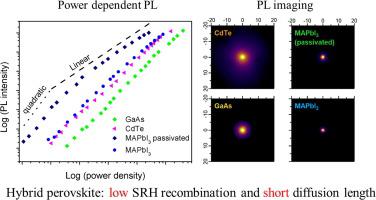当前位置:
X-MOL 学术
›
Mater. Today
›
论文详情
Our official English website, www.x-mol.net, welcomes your feedback! (Note: you will need to create a separate account there.)
Comparative studies of optoelectrical properties of prominent PV materials: Halide perovskite, CdTe, and GaAs
Materials Today ( IF 24.2 ) Pub Date : 2020-06-01 , DOI: 10.1016/j.mattod.2020.01.001 Fan Zhang , Jose F. Castaneda , Shangshang Chen , Wuqiang Wu , Michael J. DiNezza , Maxwell Lassise , Wanyi Nie , Aditya Mohite , Yucheng Liu , Shengzhong Liu , Daniel Friedman , Henan Liu , Qiong Chen , Yong-Hang Zhang , Jinsong Huang , Yong Zhang
Materials Today ( IF 24.2 ) Pub Date : 2020-06-01 , DOI: 10.1016/j.mattod.2020.01.001 Fan Zhang , Jose F. Castaneda , Shangshang Chen , Wuqiang Wu , Michael J. DiNezza , Maxwell Lassise , Wanyi Nie , Aditya Mohite , Yucheng Liu , Shengzhong Liu , Daniel Friedman , Henan Liu , Qiong Chen , Yong-Hang Zhang , Jinsong Huang , Yong Zhang

|
We compare three representative high performance PV materials: halide perovskite MAPbI3, CdTe, and GaAs, in terms of photoluminescence (PL) efficiency, PL lineshape, carrier diffusion, and surface recombination, over multiple orders of photo-excitation density. An analytic model is used to describe the excitation density dependence of PL intensity and extract the internal PL efficiency and multiple pertinent recombination parameters. A PL imaging technique is used to obtain carrier diffusion length without using a PL quencher, thus, free of unintended influence beyond pure diffusion. Our results show that perovskite samples tend to exhibit lower Shockley-Read-Hall (SRH) recombination rate in both bulk and surface, thus higher PL efficiency than the inorganic counterparts, particularly under low excitation density, even with no or preliminary surface passivation. PL lineshape and diffusion analysis indicate that there is considerable structural disordering in the perovskite materials, and thus photo-generated carriers are not in global thermal equilibrium, which in turn suppresses the nonradiative recombination. This study suggests that relatively low point-defect density, less detrimental surface recombination, and moderate structural disordering contribute to the high PV efficiency in the perovskite. This comparative photovoltaics study provides more insights into the fundamental material science and the search for optimal device designs by learning from different technologies.
中文翻译:

主要光伏材料的光电特性比较研究:卤化物钙钛矿、CdTe 和 GaAs
我们比较了三种具有代表性的高性能 PV 材料:卤化物钙钛矿 MAPbI3、CdTe 和 GaAs,在光致发光 (PL) 效率、PL 线形、载流子扩散和表面复合方面,在多个光激发密度数量级。分析模型用于描述 PL 强度的激发密度依赖性,并提取内部 PL 效率和多个相关的重组参数。PL 成像技术用于在不使用 PL 淬灭剂的情况下获得载流子扩散长度,因此,除了纯扩散之外,不会产生意外影响。我们的结果表明,钙钛矿样品在体相和表面均表现出较低的肖克利-读霍尔 (SRH) 复合率,因此比无机样品具有更高的 PL 效率,尤其是在低激发密度下,即使没有或初步的表面钝化。PL 线形和扩散分析表明钙钛矿材料中存在相当大的结构无序,因此光生载流子不处于全局热平衡,这反过来抑制了非辐射复合。这项研究表明,相对较低的点缺陷密度、较少有害的表面复合和适度的结构无序有助于钙钛矿的高光伏效率。这项比较光伏研究通过学习不同的技术,为基础材料科学和寻找最佳设备设计提供了更多见解。因此光生载流子不在全局热平衡中,这反过来抑制了非辐射复合。这项研究表明,相对较低的点缺陷密度、较少有害的表面复合和适度的结构无序有助于钙钛矿的高光伏效率。这项比较光伏研究通过学习不同的技术,为基础材料科学和寻找最佳设备设计提供了更多见解。因此光生载流子不在全局热平衡中,这反过来抑制了非辐射复合。这项研究表明,相对较低的点缺陷密度、较少有害的表面复合和适度的结构无序有助于钙钛矿的高光伏效率。这项比较光伏研究通过学习不同的技术,为基础材料科学和寻找最佳设备设计提供了更多见解。
更新日期:2020-06-01
中文翻译:

主要光伏材料的光电特性比较研究:卤化物钙钛矿、CdTe 和 GaAs
我们比较了三种具有代表性的高性能 PV 材料:卤化物钙钛矿 MAPbI3、CdTe 和 GaAs,在光致发光 (PL) 效率、PL 线形、载流子扩散和表面复合方面,在多个光激发密度数量级。分析模型用于描述 PL 强度的激发密度依赖性,并提取内部 PL 效率和多个相关的重组参数。PL 成像技术用于在不使用 PL 淬灭剂的情况下获得载流子扩散长度,因此,除了纯扩散之外,不会产生意外影响。我们的结果表明,钙钛矿样品在体相和表面均表现出较低的肖克利-读霍尔 (SRH) 复合率,因此比无机样品具有更高的 PL 效率,尤其是在低激发密度下,即使没有或初步的表面钝化。PL 线形和扩散分析表明钙钛矿材料中存在相当大的结构无序,因此光生载流子不处于全局热平衡,这反过来抑制了非辐射复合。这项研究表明,相对较低的点缺陷密度、较少有害的表面复合和适度的结构无序有助于钙钛矿的高光伏效率。这项比较光伏研究通过学习不同的技术,为基础材料科学和寻找最佳设备设计提供了更多见解。因此光生载流子不在全局热平衡中,这反过来抑制了非辐射复合。这项研究表明,相对较低的点缺陷密度、较少有害的表面复合和适度的结构无序有助于钙钛矿的高光伏效率。这项比较光伏研究通过学习不同的技术,为基础材料科学和寻找最佳设备设计提供了更多见解。因此光生载流子不在全局热平衡中,这反过来抑制了非辐射复合。这项研究表明,相对较低的点缺陷密度、较少有害的表面复合和适度的结构无序有助于钙钛矿的高光伏效率。这项比较光伏研究通过学习不同的技术,为基础材料科学和寻找最佳设备设计提供了更多见解。


























 京公网安备 11010802027423号
京公网安备 11010802027423号